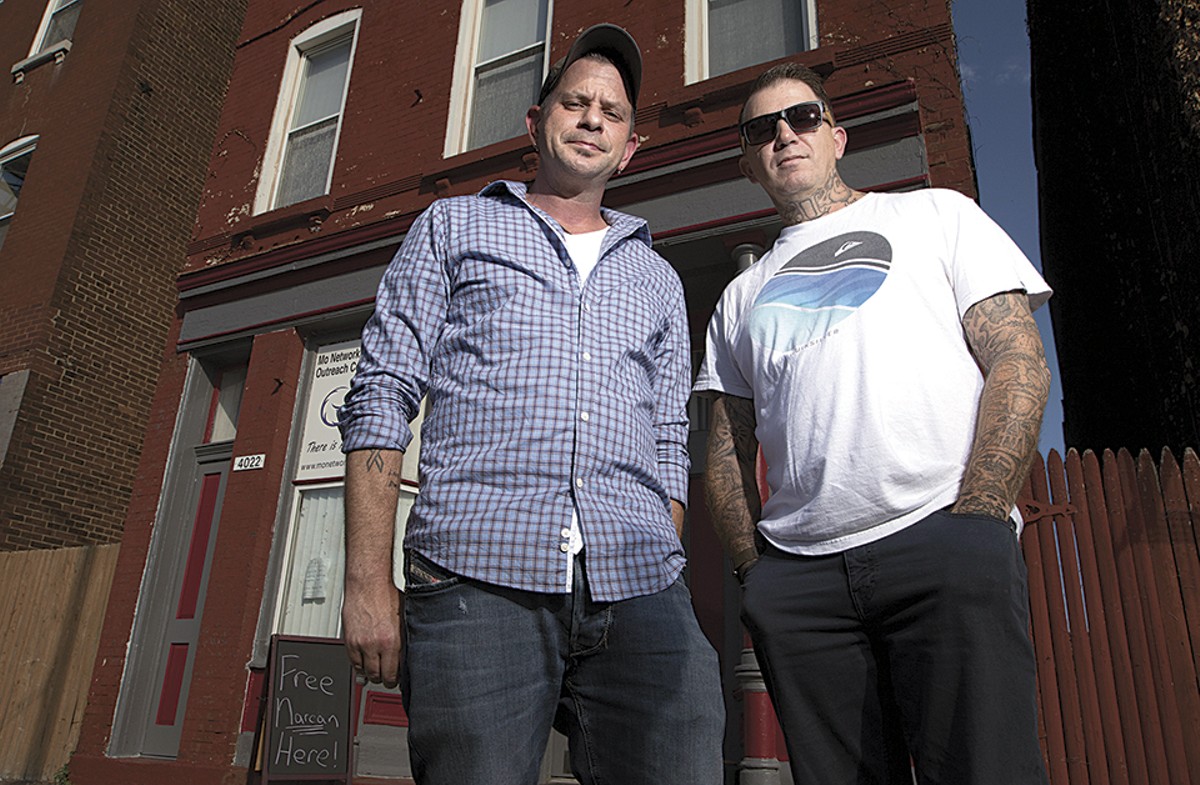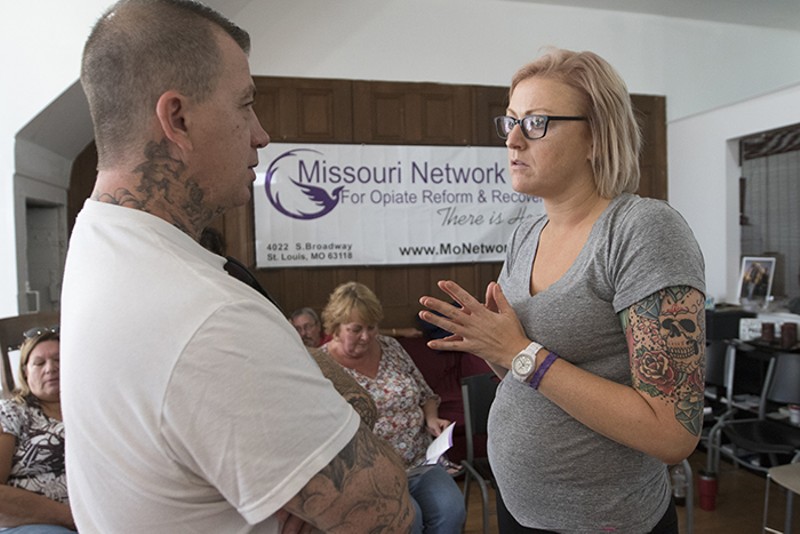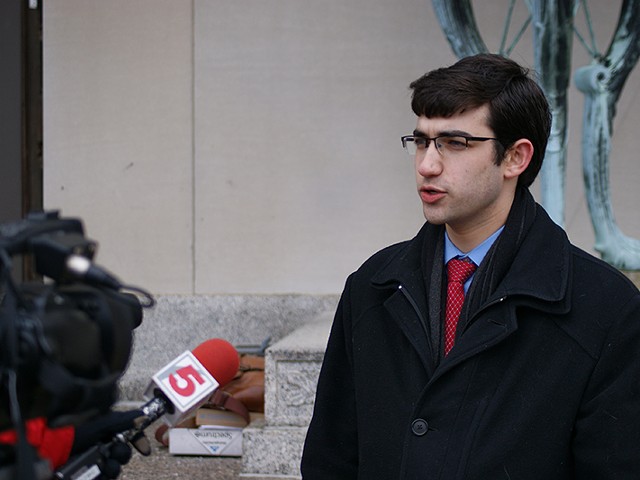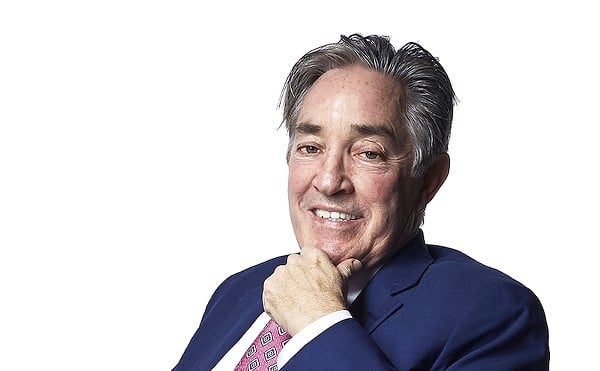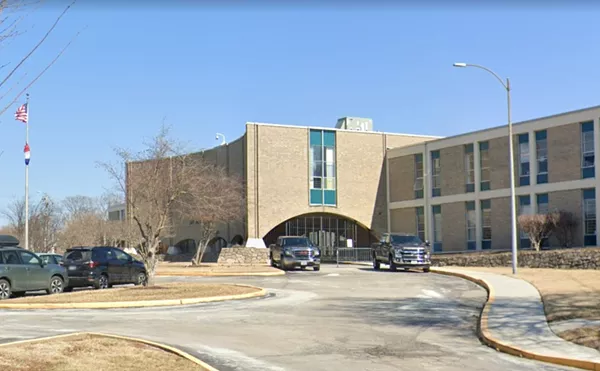Chad Sabora parks his Ford SUV in front of the former beauty parlor at 4022 South Broadway, unlocks the building's front door and disappears inside. He reappears a moment later with a sidewalk sign. Chalked on it are the words "Free Narcan Here."
The last rays of a late September sun filter through the building's ground-floor windows as Sabora sits down behind a desk, pops open a Red Bull and fires up his laptop.
Then he waits.
As co-founder of the Missouri Network for Opiate Reform and Recovery, Sabora spends a lot of his time waiting in this storefront.
The network's outreach center is one of the few places in the St. Louis region where people addicted to prescription opioid painkillers, such as OxyContin and more powerful opioids including heroin and fentanyl, can walk in off the street to obtain life-saving doses of Narcan.
Narcan stifles the effects of opioids and reverses an overdose. Sabora hands out Narcan to whoever shows up to get it, but only after visitors get a tutorial on how to use it effectively, as well as an impassioned lecture on the importance of getting into recovery.
On this warm Friday night, Sabora does not have to wait long.
Evan Reuscher, 28, walks through the door of the center, accompanied by a female friend. Reuscher explains he had almost died the night before at his house in Des Peres while doing a "speedball," a cocktail of methamphetamine and heroin. Two friends saved his life, he says.
"They gave me CPR," he says.
Sabora leads Reuscher and his friend into a small kitchen area.
"How many times have you overdosed?" Sabora asks.
"Uh, thirteen," Reuscher replies.
Sabora reaches for a cardboard box full of glass vials of Narcan. Sabora shows Reuscher and his friend how to aim a syringe into the vial and remove it quickly.
"With a twist," Sabora says.
Pantomiming with his arms, Sabora says, "Then you inject it into the arms, legs or butt."
"Arms, legs or butt," Reuscher repeats.
Sabora glares at him in a no-nonsense way, then hands him business cards to give to friends who are using.
Sabora makes a pitch for a Hep C and HIV testing, set up for the next day at the center. He follows with a second pitch, for a no-cost addiction treatment program in Colorado where Reuscher could go to detox and get clean.
"You work during the day, go to treatment at night," Sabora says.
Reuscher stays silent.
Slightly annoyed, Sabora says, "We will buy you a plane ticket to get you there if you can't afford it."
"OK," Reuscher says.
Reuscher acknowledges he almost died the night before, but the thought of dying while doing drugs does not really scare him, he says.
Reuscher's been using powerful painkillers since he was at least thirteen, when he began relying on them to help him heal from a football injury, he says. He notes that he only "dabbled" in heroin. Methamphetamine is his main drug of choice, he says.
Reuscher uses heroin because "people kept bringing it around," he says. "And it got really cheap, too. I hadn't fucked with it for a while, and the price just cut in half."
Reuscher has been through more than ten treatment programs, he says. So why hasn't he kicked the stuff yet?
Reuscher ponders the question for a beat.
"I haven't hit that point where enough is enough," he says.
America's opioid crisis is scything a widening swath through the St. Louis region. It is killing hundreds of men and women in their twenties and thirties, causing thousands more to suffer near-fatal overdoses and throwing countless families into turmoil.
It is a drug plague unlike any before it. For starters, the primary gateway for opiate addiction is not some shadowy dealer operating outside the law, but the family medicine cabinet. More than 80 percent of people hooked on heroin began with addictions to prescription painkillers.
The opioid crisis' roots reach back to the 1990s. That's when big pharmaceutical companies began flooding the consumer market with vast quantities of narcotics as the medical community came around to the notion that too many people suffering severe and chronic pain were being under-treated.
Big Pharma saw an immense money-making opportunity. It launched a decades-long push to market long-lasting, powerful opiate painkillers to both physicians and consumers.
Purdue Pharma, the maker of an extremely profitable painkiller called OxyContin — which soon acquired the nickname "Hillbilly Heroin" because of its skyrocketing popularity in Appalachia — mounted marketing campaigns that convinced physicians that OxyContin was both safe and non-addictive. As subsequent litigation shows, those claims were absurdly wrong on both counts.
Because of a set of tightly reinforcing factors — the lack of readily available treatment programs, the cheapness and enhanced purity of today's heroin and the proliferation of fentanyl, a synthetic opioid 50 times more powerful than heroin — the opiate drug crisis is far deadlier and harder to treat than its predecessors. And it shows no signs of slowing down. Both St. Louis and St. Louis County set records for accidental overdose deaths in 2016, and they are on track to set new records by the end of 2017.
Opiate overdoses are killing people all across the St. Louis metro area, from Section 8 apartments in north St. Louis to McMansions in west county to trailer parks in Jefferson County.
More than 700 people in the St. Louis region died from overdose deaths in the St. Louis area last year, with 250 in St. Louis city alone. What is especially disturbing is that fentanyl-only deaths eclipsed heroin-only deaths last year for the first time, according to James Shroba, special agent in charge of the St. Louis Drug Enforcement Administration office.
"Combine the two together, that's a staggering number of people that are losing their lives," Shroba says.
Enter Sabora and Robert Riley, who nearly two years ago opened the Missouri Network Outreach Center as a place where anyone affected by the opiate crisis — be they active users, people in recovery or their family members — can find support and learn ways to survive opiate addiction.
"Anybody at any point in substance abuse disorder can come in, whether they are actively using, whether they want help, whether they are in recovery," Sabora says. "I can tell you that everybody who comes here, we do our best to make sure they survive their addiction. We do a lot of work in harm reduction. That's our main focus."
The recovery center is located deep in south St. Louis, just past the point where Jefferson Avenue intersects Broadway. Surrounded by a neighborhood known for drug-dealing hot spots, the center also stands near several drug rehab facilities.
"We specifically chose that spot to be able to reach the using public," says Riley.
Since its opening in December 2015, the recovery center and its unpaid staff have become a beacon of hope and a source of new ideas during a time with a shortage of both.
In late August, after persistent lobbying by Sabora and Riley in Jefferson City, Missouri's 911 Good Samaritan Law took effect. The new law provides legal protection to people who call 911 "in good faith" in overdose cases, allowing witnesses to dial 911 for help without fear of arrest.
In June 2016, then-St. Louis Mayor Francis Slay signed a similar bill that would prevent police from arresting addicts who report a drug-related medical emergency in the city. It was believed to be the first municipal ordinance of its kind in the U.S. Alderwoman Cara Spencer sponsored the measure, again after lobbying by Sabora and Riley.
Sabora and Riley were also instrumental in starting a program at the St. Louis city jail that launched last month. It ensures that inmates addicted to opiates are given doses of Narcan when they leave the jail in the event they start using again and suffer an overdose.
The center receives no government funding. Its budget comes entirely from private fundraising, such as poker runs sponsored by motorcycle clubs whose members have received help there.
The center provides a wide range of services, including weekly family support group meetings, recovery meetings for current and former users, and tai chi and kung fu classes. Drug addicts who are homeless are encouraged to drop by the center for free "blessings bags," which are filled with soap, toothpaste and toothbrushes, snack food and other items that are donated by the mothers of addicts in recovery or those who've passed away.
For Sabora and Riley, the opiate crisis cuts especially close to home. Both men are themselves recovering heroin addicts who know how hard it is to break free of opiate dependency. They met on a closed Facebook page for recovery users, then became administrators of the page because of their penchant for answering group members' questions.
"And they were questions like, 'How long does withdrawal sickness last? Who hires felons?'" recalls Riley, who spent a stint in a federal prison in Arkansas on drug charges and today works as a certified drug treatment counselor.
One day a young woman asked via the page if Sabora and Riley could come over to her house for the weekend and help her kick her heroin habit.
"So we took turns," Sabora says. "We took eight-hour shifts for three days to help her."
Not long after that experience, Sabora and Riley decided to start an outreach center to keep as many people alive as possible and then shepherd them through recovery.
"There are 5,000 people getting high right now in the city," Sabora says. "How can we save them from death?"
Here's what scares the hell out of Sabora and others fighting the opiate crisis: A few years ago the progression for opiate users went like this — they would get hooked on prescription opiates, prescribed either for themselves or someone else. And then, once the prescription ran out, they would switch to heroin, which would be mixed with fentanyl or other substances.
But now, in a trend helping power the record-setting number of overdose deaths, users are going straight to fentanyl, Sabora says.
"Fentanyl has a stronger rush — you get that warm feeling in your stomach when you use it," he says.
Fentanyl offers the prospect of a more intense high but one with a shorter half-life — conditions guaranteed to raise future body counts.
"But now that's all the young kids want," Sabora says.

